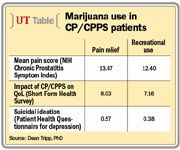Article
Marijuana use prevalent among chronic prostatitis/chronic pelvic pain syndrome patients
Author(s):
With marijuana legalized for medical use in Canada since 2001 and now in 17 U.S. states and the District of Columbia, urology patients in pain have been turning to marijuana for relief.

Key Points
Atlanta-It's a topic that's taboo for many urologists, but one that needs to be discussed-medical marijuana.
With marijuana legalized for medical use in Canada since 2001 and now in 17 U.S. states and the District of Columbia, beginning with California in 1996, urology patients in pain have been turning to marijuana for relief. We need to find out if they're getting it.
Dean Tripp, PhD, associate professor of psychology at Queen's University in Kingston, Ontario, took a first step to do just that by surveying patients with chronic prostatitis/chronic pelvic pain syndrome (CP/CPPS) about their use of marijuana and whether it relieved their pain.

Not surprisingly, the mean pain score was higher in the pain users than in the recreational users (13.47 vs. 12.40 on the NIH Chronic Prostatitis Symptom Index), as was the impact of CP/CPPS on quality of life (8.03 in the pain users vs. 7.16 in recreational users on the Short Form Health Survey). Also not surprisingly, suicidal ideation was higher in the pain users than in the recreational users (0.57 vs. 0.38 on the Patient Health Questionnaire for depression).
Although the survey did not ask questions about degree of pain relief from or access to traditional pain management medications and techniques, it seems likely that many users of marijuana for pain are those who haven't had adequate relief from prescribed medications or other pain therapies. Marijuana can offer added relief, as a study at San Francisco General Hospital showed. Vaporized cannabis was found to augment the analgesic effects of opioids in chronic pain patients without significantly altering plasma opioid levels (Clin Pharmacol Ther 2011; 90:844-51).
There were no differences between the pain users and recreational users in the degree of side effects, reasons for stopping, use and frequency, or dose smoked. Among those taking in marijuana in food, pain users tended to use more, with 24% reporting consuming more than 1 gram per dose compared with 9% of recreational users consuming this amount.
Importantly, the survey asked whether the cannabis was of any benefit in treating or relieving symptoms.
"At this point in time, with the limited data we have on the matter, the answer for the majority of users is 'yes,' " said Dr. Tripp, who worked on the study with the psychology, urology, and anesthesia departments at Queen's University.
Of the 58 pain users who answered that question, a sizable majority-67%-said that it did indeed offer pain relief. Very few recreational users answered this question, but of the nine who did, three (33%) said it was beneficial for pain, whereas six (67%) said it wasn't. Compared with many treatments tried in the urologic pelvic pain syndromes, effectiveness in 33% isn't bad, and in 67%, it's remarkable.
Survey studies including more patients would be needed to confirm that figure.














